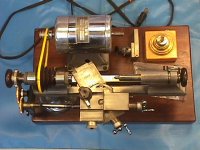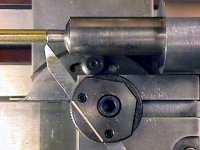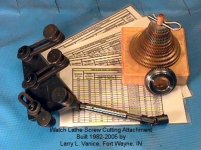jlakes85
Aluminum
- Joined
- Sep 10, 2011
- Location
- Northern NJ
Looking for guidance and past experience regarding smallest thread size for practical lathe single pointing using both HSS and carbide tooling. Always appreciated.
Follow along with the video below to see how to install our site as a web app on your home screen.
Note: This feature may not be available in some browsers.
Depends a lot on the material. I can tell you from experience that 0-80 in 0.9999 silver has a low probability of success.
Well, "practical lathe single pointing" is kind of a broad expression. What lathe and what material and male or female? My Levin and Derbyshire lathes can make watch-size male threads with pitch as fine as 200 TPI. I have only gone down to .060-90 threads to make a knurled head steel thumb screw on a Levin, but I could have gone smaller if I really had to.Looking for guidance and past experience regarding smallest thread size for practical lathe single pointing using both HSS and carbide tooling. Always appreciated.




My dad single pointed an 0-80 on a 16" lathe on a bet.


Oh YEAH? Well my dad could do 00-00100 on a 28" lathe
Looking for guidance and past experience regarding smallest thread size for practical lathe single pointing using both HSS and carbide tooling. Always appreciated.

I am interested in answers as well.
I have no experience making really fine threads, but wish to, on good cnc equipment, in steel.
Thus, any practical experience in steel is valued and appreciated.
Hoping to do approx 0.1-0.2 mm rise threads, or about 80-125 tpi.
And in trapezoidal, aka acme.
Micrometer threads.
All that has learning curves.
USUALLY, there are specialist makers who not only do threaded goods better than most, they've driven the unit costs down. Ballscrews and common Acme forms for everything from uber-precise machinery leads to not-so-critical vise clamping or automotive lifts are good examples. So are fasteners for watches and fine instruments.
Makes more sense to purchase, UNLESS.. the threaded portion is so integral to some major component, it cannot be readily hived-off.
Your micrometer screws probably can be severed, sent to an already-established specialist with a hundred and more years 'head start' at the game.
My dad single pointed an 0-80 on a 16" lathe on a bet.
It wasn't the 0-80, 000-120 was not too hard on that lathe, it was the 0.9999 silver. It was just too soft, and while we probably could have figured out how to do it, the material was so expensive it wasn't practical to practice very much.
forming threads goes back to Maudslay and the first lathes

Notice
This website or its third-party tools process personal data (e.g. browsing data or IP addresses) and use cookies or other identifiers, which are necessary for its functioning and required to achieve the purposes illustrated in the cookie policy. To learn more, please refer to the cookie policy. In case of sale of your personal information, you may opt out by sending us an email via our Contact Us page. To find out more about the categories of personal information collected and the purposes for which such information will be used, please refer to our privacy policy. You accept the use of cookies or other identifiers by closing or dismissing this notice, by scrolling this page, by clicking a link or button or by continuing to browse otherwise.
